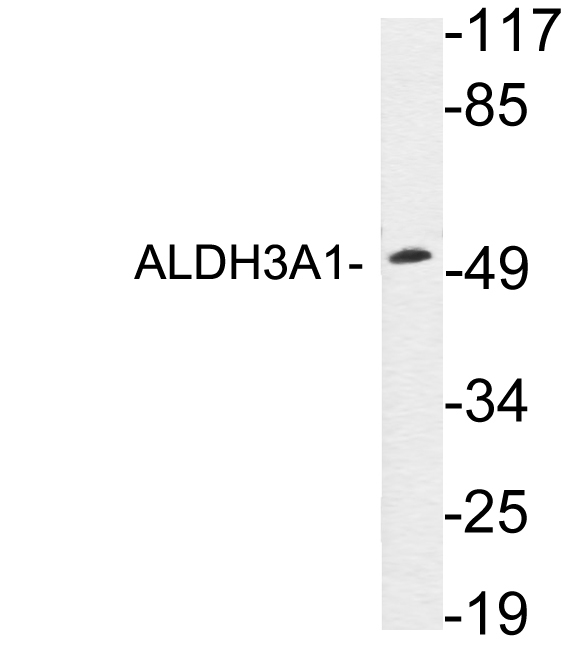ALDH3A1 Polyclonal Antibody
- Catalog No.:YT5025
- Applications:WB;ELISA
- Reactivity:Human;Rat
- Target:
- ALDH3A1
- Fields:
- >>Glycolysis / Gluconeogenesis;>>Histidine metabolism;>>Tyrosine metabolism;>>Phenylalanine metabolism;>>beta-Alanine metabolism;>>Metabolism of xenobiotics by cytochrome P450;>>Drug metabolism - cytochrome P450;>>Metabolic pathways
- Gene Name:
- ALDH3A1
- Protein Name:
- Aldehyde dehydrogenase dimeric NADP-preferring
- Human Gene Id:
- 218
- Human Swiss Prot No:
- P30838
- Mouse Swiss Prot No:
- P47739
- Rat Gene Id:
- 25375
- Rat Swiss Prot No:
- P11883
- Immunogen:
- The antiserum was produced against synthesized peptide derived from human ALDH3A1. AA range:236-285
- Specificity:
- ALDH3A1 Polyclonal Antibody detects endogenous levels of ALDH3A1 protein.
- Formulation:
- Liquid in PBS containing 50% glycerol, 0.5% BSA and 0.02% sodium azide.
- Source:
- Polyclonal, Rabbit,IgG
- Dilution:
- WB 1:500 - 1:2000. ELISA: 1:20000. Not yet tested in other applications.
- Purification:
- The antibody was affinity-purified from rabbit antiserum by affinity-chromatography using epitope-specific immunogen.
- Concentration:
- 1 mg/ml
- Storage Stability:
- -15°C to -25°C/1 year(Do not lower than -25°C)
- Other Name:
- ALDH3A1;ALDH3;Aldehyde dehydrogenase, dimeric NADP-preferring;ALDHIII;Aldehyde dehydrogenase 3;Aldehyde dehydrogenase family 3 member A1
- Observed Band(KD):
- 50kD
- Background:
- Aldehyde dehydrogenases oxidize various aldehydes to the corresponding acids. They are involved in the detoxification of alcohol-derived acetaldehyde and in the metabolism of corticosteroids, biogenic amines, neurotransmitters, and lipid peroxidation. The enzyme encoded by this gene forms a cytoplasmic homodimer that preferentially oxidizes aromatic and medium-chain (6 carbons or more) saturated and unsaturated aldehyde substrates. It is thought to promote resistance to UV and 4-hydroxy-2-nonenal-induced oxidative damage in the cornea. The gene is located within the Smith-Magenis syndrome region on chromosome 17. Multiple alternatively spliced variants, encoding the same protein, have been identified. [provided by RefSeq, Sep 2008],
- Function:
- catalytic activity:An aldehyde + NAD(P)(+) + H(2)O = an acid + NAD(P)H.,function:ALDHs play a major role in the detoxification of alcohol-derived acetaldehyde. They are involved in the metabolism of corticosteroids, biogenic amines, neurotransmitters, and lipid peroxidation. This protein preferentially oxidizes aromatic aldehyde substrates. It may play a role in the oxidation of toxic aldehydes.,similarity:Belongs to the aldehyde dehydrogenase family.,subunit:Homodimer.,tissue specificity:High levels in stomach, esophagus and lung; low level in the liver and kidney.,
- Subcellular Location:
- Cytoplasm .
- Expression:
- High levels in stomach, esophagus and lung; low level in the liver and kidney.
- June 19-2018
- WESTERN IMMUNOBLOTTING PROTOCOL
- June 19-2018
- IMMUNOHISTOCHEMISTRY-PARAFFIN PROTOCOL
- June 19-2018
- IMMUNOFLUORESCENCE PROTOCOL
- September 08-2020
- FLOW-CYTOMEYRT-PROTOCOL
- May 20-2022
- Cell-Based ELISA│解您多样本WB检测之困扰
- July 13-2018
- CELL-BASED-ELISA-PROTOCOL-FOR-ACETYL-PROTEIN
- July 13-2018
- CELL-BASED-ELISA-PROTOCOL-FOR-PHOSPHO-PROTEIN
- July 13-2018
- Antibody-FAQs
- Products Images

- Western Blot analysis of extracts from A549, K562 cells, using ALDH3A1 Polyclonal Antibody. Secondary antibody(catalog#:RS0002) was diluted at 1:20000

- Western blot analysis of lysates from A549 cells, using ALDH3A1 antibody.



